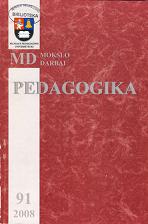Vienišumo jausmą išgyvenančių paauglių elgesio ypatumai
On Peculiarities in the Behaviour of Adolescents Suffering From Loneliness
Author(s): Jūratė Laurinavičiūtė, Nijolė CibulskaitėSubject(s): Education
Published by: Vytauto Didžiojo Universitetas
Keywords: adolescents; behaviour; loneliness
Summary/Abstract: In 2007 there was a study carried out with the aim of researching the problem of loneliness in adolescents with 1443 respondents in forms 5 to 10 of secondary schools in Lituania. the study enabled us to establish the frequency of teenager states of loneliness both at school and in home surroundings: we also revealed ways of overcoming the states of loneliness that had been chosen by teenagers. Loneliness manifests itself as a negative emotion-al state which results in the individual's experiences of subjective feelings of inner emptiness, isoliation from other individuals and lack of social contacts. Adolescents tend to relate their feelings of loneliness to the feelings of unhappiness, to the fear of separation and the states of remotedness from their parents, relatives and peers, with the inevitable followup of experienced sadness, high levels of stress, social anxiety and aloofness as well as a sence of being rejected by peers. The obtained data proved that the states of loneliness at school were most frequently experienced by school learners in forms 9 and 10, also in forms 5 and 6 whereas the school learners in forms 7 and 8 were found to have experienced the state of loneliness somewhat less frequently. In their home surroundings, the learners in forms 9 and 10 felt loneliest of all, and the learners in form 6 also felt in a very similar way whereas the learners in forms 5 and 8 felt least lonely of all. Only the learners in forms 5 and 7 felt lonelier at school than in their home surroundings whereas the learners of remaining forms felt lonelier in home surroundings that at school. About one tenth of all our responents stated that they experienced constant states of lonelines both at school and in home surroundings, there were no significant differences revealed by the study in the experienced feelings of loneliness between girls and boys. The data of the study also provided evidence about how teenagers handled the states of loneliness, and more than half of all respondents pointed out that at school they seeked contacts with their peers; up to three quarters of all respondents stated that they tried individually to find some kind of occupation. the learners in forms 5 and 9 pointed out that they most commonly busied themselves by watching television or playing computer games. Fifthformers pointed out that they tended to fight loneliness by reading, taking care of their pets, keeping a diary: but the study also revealed a clearly expressed tendency in adolescents for the need of social contacts which was noticed as increas-ing with age. In the situations of prevailing states of loneliness, the adolescents chose to communicate with their parents, siblings as well as grandparents and other close relatives...
Journal: Pedagogika
- Issue Year: 2008
- Issue No: 91
- Page Range: 95-100
- Page Count: 6
- Language: Lithuanian

